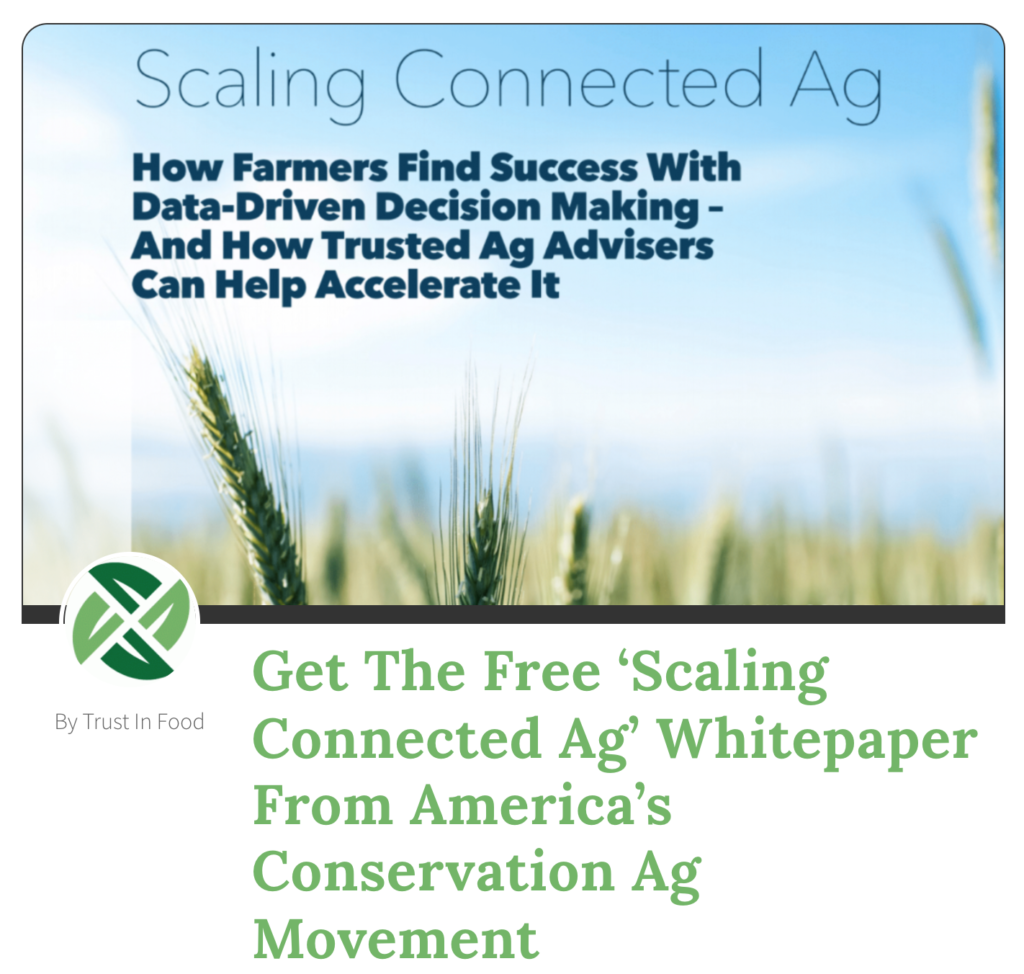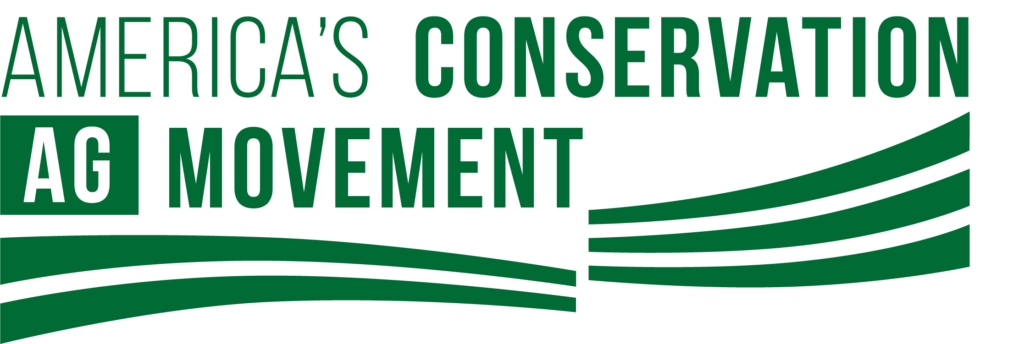Building regenerative ag systems
Building regenerative ag systems
Trust In Food + ACAM go truckin’ to discuss how farmers and data play a crucial role in growing “next-gen” agriculture
By: Jason Tatge, senior vice president of AGI SureTrack and co-founder of Farmobile
Editor’s Note: AGI, along with its Farmobile data collection brand, is the latest Founding Partner to join the public-private partnership, America’s Conservation Ag Movement (ACAM). Organized by Trust In Food™ and Farm Journal Foundation, ACAM empowers collaborators to leverage Farm Journal’s 145-plus years of market trust and farmer-to-farmer networks to accelerate the adoption of regenerative practices, products and technologies.
This summer I invited Mitch Rouda, founder of Trust In Food and Chief Strategy Officer at Farm Journal, and Amy Skoczlas Cole, executive vice president of Trust In Food, to go Trucking with Jason for a journey down rural roads past Kansas fields. As we checked out the crops, we talked about how ACAM and Trust In Food are focused on expanding awareness for U.S. farmers’ accomplishments in conservation and stewardship and accelerating adoption of new practices that benefit farmers, the ag-food supply chain, and, ultimately, the consumer.
WHAT IS TRUST IN FOOD?
Jason: Mitch, I know that Trust In Food has been a project of Farm Journal’s for quite a while. Tell us about the birth of Trust In Food, what you’re doing today, and where it’s going?
Mitch: It’s probably important to start with a mention about who Farm Journal is. Farm Journal has a unique and iconic position in agriculture as the long-term defender of farming practices, both as an educator and as a trusted voice. One of the things we’ve done throughout the storied history of the company is to guide the industry through change.
Six years ago, we started to realize the magnitude of change confronting agriculture. The ESG demands of consumer product companies—from consumers to retailers to consumer products companies — were going to require probably two things different in agriculture. One is more transparency, which means more measurement… and the other is steady progress on a whole range of sustainability goals or regenerative ag goals.
Amy: What we’re doing with Trust In Food today is evolving on where the program started. How do we accelerate the adoption of more regenerative and sustainable practices at the farm level, but also, how do you get the supply chain engaged in supporting producers through that, and how do you help connect to consumers to be more understanding and aware of what life looks like?
Consumers today are far away from the farms that feed them, which is different from any other time in our country’s history. What we’re really building is a bridge. I talk about us as sort of a translator back and forth between consumers, food companies, agribusiness, and ultimately the farmers that Farm Journal serves.

WHAT ARE YOUR GREATEST BARRIERS?
Jason: What are some of the barriers you run into? Because I’m sure they’re a lot of the same ones that we see at AGI and Farmobile.
Amy: I think, obviously, the biggest barrier is really, what’s in it for the producer? But underneath that, one of the things that Farm Journal has—which is this tremendous asset — is a deep understanding and information about how producers are thinking and what they care about today. No other multi-billion dollar industry goes out there without actually listening to the people they’re trying to serve.
Jason: It’s crazy, isn’t it?
Amy: It is crazy. And that’s what conservation agriculture sort of does, so we’re trying to be that gift. We’re trying to fill in, and say, “Here’s what producers actually need.” That may be additional financial incentives, but it may also be understanding how they see the world or what they’re worried about for their operations.
WHAT ROLE DOES DATA PLAY IN A CHANGING AGRICULTURE?
Jason: Agriculture moves at the speed of trust and you can’t accelerate trust. It’s something you have to earn. And, that’s the hard thing about ag tech startups in this business.
Mitch: That’s why you test, and that’s why it takes three years to make a change on-scale. On the other hand, some changes in agriculture do go fast when the benefit is compelling. Just think how fast GMO corn took off. It didn’t take that long to see what the benefits were.
Meaningful benefits that are immediate. Now, some of this is still future-proofing and we were having this conversation about data collection. One of the requirements that’s inevitable in the future of farming is more transparency back to the farm. Everybody can see it. How fast it’s going to come, we don’t know. You hope it doesn’t get burdened on farmers in a way that they can’t comply or accommodate, but if you take the long view, it’s coming,
Jason: There’s such a massive opportunity to modernize the information or the data collection methods in agriculture, whether it be through the USDA reports or how we document what products are being used on the crop, planting and harvest dates, etc. — all of this information that we see people recording with a pen and paper. And it’s a guess.
Amy: Well, I think that really speaks to a need. Trust In Food helped Farm Journal produce a data report that primarily surveyed row crop farmers up and down the middle of the country. What we were really trying to understand is, how are farmers seeing data and digital agriculture? Because again, from our perspective, data is sort of the gateway to everything. It’s the gateway to carbon markets, to transparency for consumers, for producers to actually get rewarded and incentivized based on what they do.
Mitch: It’s the gateway to encourage change. If you want to accelerate change, then you need to be into watching all this stuff.
Amy: The interesting thing—and sort of slightly depressing thing—that comes out of this report is that you have close to 70% of farmers who are not using any sort of digital product whatsoever to keep their records. It’s the envelope, the pencil and paper, sitting down, it’s in their heads for a lot of them.
So, then we went out and asked them “why.” Here are a couple of things that I think we have to figure out. The biggest reason was, “I don’t really trust,” so this goes all the way back to trust. We talked about change happening at the speed of trust, and farmers are saying, “I don’t really trust what’s going to happen to my data.”
Candidly, I think underlying some of that is, “Are you going to use this to further intrude in my operation?” Whether it’s you, the government, or you, a food company, it feels like the trust isn’t there for them to “turn over” that data.
TRUST IN FOOD’S BIG CHALLENGE
Jason: What type of data is going to be required for them to be able to really maximize their investment in collecting that data?
Amy: Today it’s carbon, carbon, carbon, carbon, carbon, carbon.
Jason: Is it real? Is all the hype real? Or is it something that’s been passed to the marketing department for a lot of large organizations?
Amy: I think it’s really up to all of us (the industry) to figure out whether or not we can make it real. I don’t think it’s real today, but the opportunity that agriculture has to be a positive solution for climate change is real. What farmers are doing and the decisions that they’re making can suppress the carbon in the soil and help prevent nitrogen escape. They can also make decisions that aren’t doing that, so the opportunity is real.
I think it’s a really interesting opportunity too. I’ve been at this for 27 years, and this is the first time I’ve seen farmers, ranchers, and producers cast as heroes as opposed to villains. We’ve been talking about how big the dead zone is in the Gulf (of Mexico). Absolutely real. But we haven’t actually said, “How can you be part of the solution?”
What’s exciting is how deeply agriculture has absorbed that as an opportunity. Now we actually have to make it real. The science is there. We know what to do. Producers know what to do. Now we have to figure out how to measure it? How do you prove it? How do you make sure that you’re not double-counting (the data for credits)? The rules of the road, as they were, still have to be developed.
WHAT’S ON THE HORIZON?
Jason: High-quality grain doesn’t need to go through the elevator anymore. It’s worth more not to go through the elevator. I was in the grain marketing business for a long time. We took the good stuff, we took the lower quality stuff, and we blended it together to make it average quality. That’s the game that’s been around for a long time. But when you can verify how you grew the grain, you can take some samples of the grains going into the bin, and you can prove that it never got above certain temperatures. Suddenly, you’ve got a grain product that’s different. You’ve got a premium product.
Amy: Small density differences. I think that is actually where all of this ends up. The endpoint is not carbon or even manufacturing specs. I actually think it’s “How are you going to de-commoditize based on nutritional density?”
There is such an opportunity in this generational change coming up. If you think about how the role of a farm operation leader has changed from generation to generation, this is the generation of self-driving tractors.
This is their thing. This is how it’s going to look totally different, and I really feel like we owe it to agriculture to make sure that we’re getting that out there. How do we make it cool and fun and interesting? Do we inoculate it into the universe?
There’s more conversation. Lots more.
ACAM + DATA MATTERS
AGI (Ag Growth International) along with its Farmobile data brand recently joined America’s Conservation Ag Movement (ACAM) and Trust In Food. Find out “why” we think this movement matters to farmers, ag retailers and their ag-food partners!


Posted on December 14, 2021 by Agi Schafer-Kreiser
ACAM, ag-food supply chain, AGI, Amy Skoczlas Cole, climate change, conservation, consumers. Ag data, data, ESG, Farm Journal, food, Jason Tatge, Mitch Rouda, next gen, regenerative ag, regenerative agriculture, soil health, stewardship, SureTrack, sustainability, trucking with jason, trust, Trust in Food, trusted voice, US farmers
Copyright © 2024 · All Rights Reserved · Farmobile
This website uses cookies to understand how you use our site and to improve your experience. By continuing to use our site, you accept our use of cookies, but you can opt-out if you wish. Accept Privacy Policy
Privacy & Cookies Policy
Privacy Overview
This website uses cookies to improve your experience while you navigate through the website. Out of these, the cookies that are categorized as necessary are stored on your browser as they are essential for the working of basic functionalities of the website. We also use third-party cookies that help us analyze and understand how you use this website. These cookies will be stored in your browser only with your consent. You also have the option to opt-out of these cookies. But opting out of some of these cookies may affect your browsing experience.
Necessary cookies are absolutely essential for the website to function properly. This category only includes cookies that ensures basic functionalities and security features of the website. These cookies do not store any personal information.

